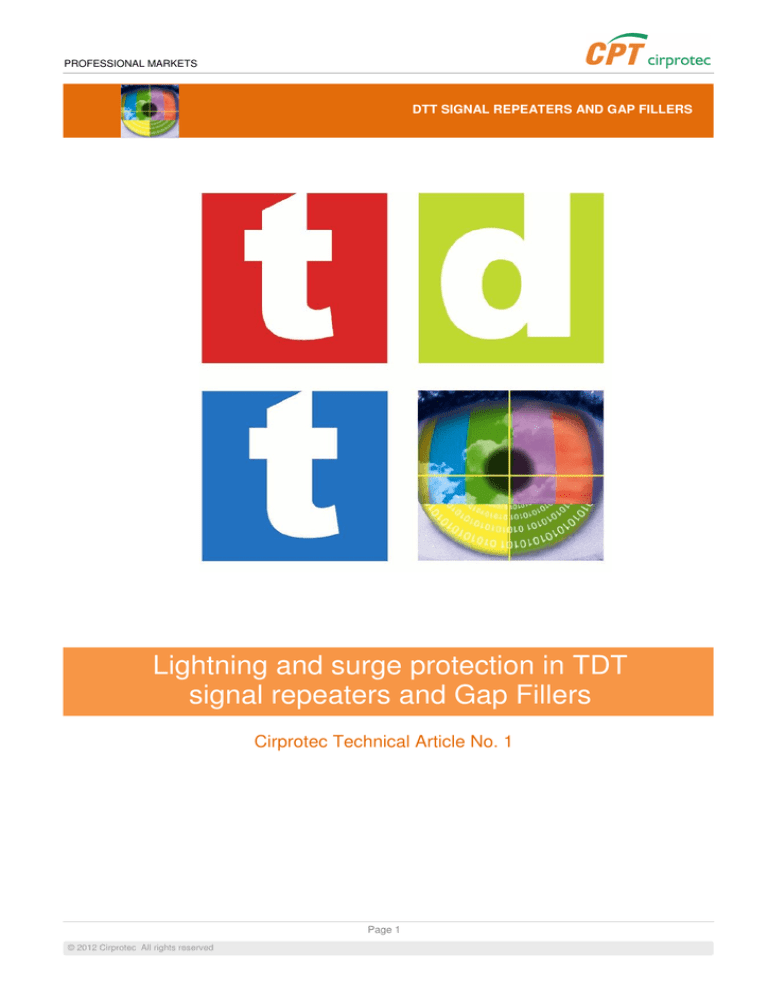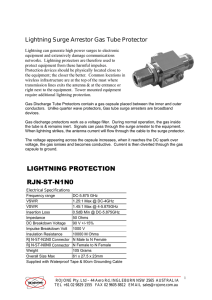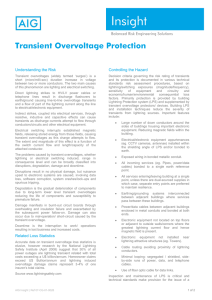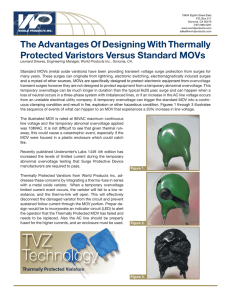
PROFESSIONAL MARKETS
DTT SIGNAL REPEATERS AND GAP FILLERS
Lightning and surge protection in TDT
signal repeaters and Gap Fillers
Cirprotec Technical Article No. 1
Page 1
© 2012 Cirprotec All rights reserved
PROFESSIONAL MARKETS
DTT SIGNAL REPEATERS AND GAP FILLERS
0.
Introduction
Spain's National Technical Plan for Terrestrial Television, reflected in Spanish Royal Decree 944/2005, set
3 April 2010 as the date for cessation of analogue terrestrial television broadcasts. On this day, known as
the “analogue switch-off”, digital technology will completely replace analogue technology.
For this change to be possible, a new network of signal repeaters needs to be implemented around the
country. These signal repeaters will be located at previously analysed points to be able to cover the
maximum area possible, taking advantage of the network of existing installations and creating new ones.
However, due to the irregularities of the land itself, “shadow” zones will be created, which the signal cannot
reach. It is therefore necessary to boost the signal from each transmitter with gap fillers, which will ensure
signal quality in all areas.
Both the main transmitters and the gap fillers are located on hills or in very open areas, and so are very
exposed to surges and overvoltages from atmospheric sources. In addition, the transmitter or gap filler
devices for cleaning and retransmitting the signal have electronic components which are very sensitive to
these overvoltages. For both these reasons, DTT signal broadcast installations are especially sensitive to
overvoltage problems.
Both the transmitters and the gap fillers have high exposure to overvoltages from
atmospheric sources.
The cost of the devices making up these installations and the importance of service continuity make the
installation of proper overvoltage protection highly necessary. These protectors will shunt to ground any
induced or conducted voltage surge produced by lightning, protecting the receivers and ensuring service
continuity.
Additionally, if the repeater location makes direct lightning strikes likely, an external lightning protection
system must be installed using lightning rods with a streaming device. In the case of a direct lightning
strike, this system will attract the discharge and shunt it to earth, preventing a strike on any antenna and
avoiding costs for damages and service discontinuities.
Fig. 1. Schematic of the DTT broadcast system, made up of repeaters and gap fillers.
Page 2
© 2012 Cirprotec All rights reserved
PROFESSIONAL MARKETS
DTT SIGNAL REPEATERS AND GAP FILLERS
1. What are overvoltages?
When analysing the phenomenon of overvoltages, a distinction is always made between transient
overvoltages (surges) and permanent overvoltages (TOV). Although they both represent an increase in
voltage above the allowable limit, their causes, magnitude, duration and method of protection are different.
Transient overvoltages are surges that can reach tens of kilovolts with a duration of the order of
microseconds.
icroseconds. Despite their short duration, the high energy content can
cause serious problems to equipment connected to the line, from premature
aging to destruction, causing disruptions to service and financial loss.
Thiss type of overvoltage can have various different causes, including
atmospheric lightning directly striking the external protection (lightning rods)
on a building or transmission line or the associated induction of
electromagnetic fields in metallic conductors.
conduct
Outdoor and very long lines are
the most susceptible to these fields, often receiving large induction currents. It
is also common for non-weather
weather phenomena, such as transformer centre
switching or switching off motors or other inductive loads to cause voltage
spikes in adjacent lines.
Fig. 2. Transient overvoltage
Transient overvoltages are voltage spikes of tens of kilovolts with a duration of
microseconds.
Surge protection is achieved by installing the protector or line discharger on the vulnerable line, connecting
it in parallel between the line and earth. This means that in the event of a surge, the protector will discharge
excess energy to earth, thus limiting
iting the peak voltage to a value which the electrical equipment connected
can withstand.
Besides the phenomenon of transient
overvoltages, which may affect any
type of conductor, electric transmission
lines can transmit
ansmit a second type of
overvoltage, known as permanent
overvoltage (TOV).. This is considered
to be any voltage increase above 10%
of the effective nominal value during a
period of the order of seconds.
Permanent overvoltages are caused by
supply problems, or, very often, by bad
connections or breakage of the neutral
Fig. 3. Permanent Overvoltage (TOV)
conductor. When the latter occurs, the
single-sided
sided voltage received by any
system connected between phase and neutral is floating and depends on the imbalance of the charge on
the three-phase network, and can supply as much as 400 effective Volts instead of the 230 V expected. An
increase in effective voltage may lead to premature aging of receivers, current increases or even their
destruction, with the resultant fire risk.
The protection method
od for this type of overvoltage consists of monitoring the voltage between each of the
phases and neutral and breaking the circuit if this value rises to over 10% above nominal.
Page 3
© 2012 Cirprotec All rights reserved
PROFESSIONAL MARKETS
DTT SIGNAL REPEATERS AND GAP FILLERS
1.
Necessary Protection
Based on the above, two types of protection are available for these types of installations: External
protection, based on lightning capture and internal protection to shield from the different overvoltages
induced in the cables.
Internal protection is aimed at preventing overvoltages from damaging the receivers. The overvoltage
protectors are connected to the cables which may receive the overvoltage and, in the case of an
excessively high voltage spike, will shunt it to ground, so limiting the voltage the receiver receives to a
value it can withstand. As shown in Figure 4, possible routes for overvoltage in these types of installations
are coaxial and power distribution cables in the case of transient overvoltages, and power distribution
cables in the case of power frequency overvoltages.
Fig. 4. Possible routes for overvoltages in a repeater or gap filler
n
To provide protection from induced overvoltages in coaxial cables, it is necessary to install a protector from
the CT10 range in each of the conductors running from the antennas, both receivers and transmitters. The
CT10 range includes protectors with all the connectors these types of installations use: N, BNC, F, TNC,
NW, UHF, etc. These protectors must be installed as close as possible to the equipment. Installed in series
with the signal, they limit the overvoltage to a peak value below that which can be withstood by the
receiver, so guaranteeing its protection. This protector is compatible with all coaxial cable signals as it
offers an insertion loss of less than 0.5 dB, an impedance of 50 or 75 ohms and a bandwidth of 2.5 GHz.
Signal surge protectors limit the overvoltage to a peak value below that permissible by
the receiver, so protecting it from any damage.
Page 4
© 2012 Cirprotec All rights reserved
PROFESSIONAL MARKETS
DTT SIGNAL REPEATERS AND GAP FILLERS
The second possible
ible path for propagation is the power distribution line. As noted in the previous point, this
path can also propagate a second type of overvoltage - power frequency overvoltages. For this reason a
single protector, the V-Check
Check 4MR, will be installed, protecting
prot
against both power frequency and transient
overvoltages. If an effective voltage higher than that permissible is received, the only possible solution is to
disconnect the installation to prevent fire and damage to receivers. Due to the importance of service
continuity in these types of installations and their possible remote location, this protector will have an
automatic reconnection feature. When the input voltage returns to values which are safe for the installation,
the equipment will reconnect. The protector includes an MCB circuit breaker.
The automatic reconnection feature is necessary in these types of overvoltage
protectors due to the need to guarantee service continuity of remote sites.
Figure 5 below shows how these protectors are installed in the system: coaxial protectors for the gap filler
input cables and power frequency and transient overvoltage protectors in the electrical panel.
Fig. 5. Installation of the necessary
protectors
If the installation has external lightning
protection, the mains protection will need to be upgraded, as it will
not only receive induced overvoltage, but also conducted overvoltage. CS1-100
CS1 100 single-pole
single
protectors will
be installed for this situation, for transient overvoltages, along with the OVERCHECK programmable power
frequency overvoltage protector. Both these products are detailed in Figure 7.
If the installation has external lightning protection, the mains protection will need to be
upgraded (due to the induced and conducted overvoltages)
Some sites use working voltages of 24 Vdc or 48 Vdc for specific regulatory reasons or for safety. These
voltages come from a source powered at 230 Vac or from a photovoltaic system. If the site has a power
supply, in addition to the protection mentioned above, which will be installed "upstream" of the source,
protection is also necessary at the power supply outlet. suitably dimensioned for these types of voltage. If,
on the other hand, the site is powered by means of a photovoltaic installation, there will be no need to
protect against power frequency overvoltages. Protection will be exclusively against transient overvoltages,
following the same guidelines as described before, but with products specifically for
for these voltages.
Page 5
© 2012 Cirprotec All rights reserved
PROFESSIONAL MARKETS
DTT SIGNAL REPEATERS AND GAP FILLERS
External protection is essential to guarantee protection against direct lightning strikes and so prevent injury
and damage to equipment. The protection system consists of a capture element, responsible for attracting
the lightning, a down conductor with its fittings, responsible for shunting the energy from the lightning to
ground, and a grounding system.
A lightning rod with a streaming device will be used as a capture
element. This type of lightning rod achieves more efficient
protection by offering greater radii of coverage. Systems called
Franklin
rods
have
traditionally
been
installed
on
telecommunications towers. The coverage zone of these is a cone
rather than a radius of coverage. As such, they cannot guarantee
the protection of the antennas, the buildings or the people in the
neighbourhood of the tower. To ensure correct discharging of the
energy, a down conductor must be installed from the lightning rod,
using an adaptor to guarantee continuity between the down
conductor and the lightning rod itself. This down conductor must be
anchored to the structure with supports to be able to resist the
mechanical forces to which it is subject when the discharge occurs.
Finally, this down conductor will be connected to its own grounding
installation. This must be different and independent from the
tower's own grounding system, but the two must be interconnected
to guarantee equipotentiality and so achieve correct protection.
Lightning rods with streaming devices offer better
protection (greater radius of coverage)
If the tower structure is sufficiently large, greater than 3 mm think,
the structure itself can be used as the down conductor. It is
important to stress that each of the grounding systems separately
must have a maximum value of 10 ohms.
Page 6
© 2012 Cirprotec All rights reserved
Fig. 6. External protection installation
PROFESSIONAL MARKETS
DTT SIGNAL REPEATERS AND GAP FILLERS
2. Final Conclusion
As explained in this article, to prevent damage and service interruptions, it is necessary to protect all the
possible overvoltage paths. Depending on the exposure of the transmitter or gap filler location, an external
protection system may be necessary. As a general rule, due to site locations, main transmitters will require
external protection due to their increased exposure to atmospheric phenomena, whereas for gap fillers,
internal protection will usually be sufficient. As stated, the internal protection will change if there is external
protection too. The figure below shows the two scenarios: protection needed when there is a lightning rod
and when there is not.
Internal protection solution (e.g. Gap Filler)
1.
CT10-N (Code 77801650), installed as close as
possible to the gap filler and in each of the coaxial
cables from the tower. (Available with other
connectors)
2.
V-Check 4MR (Code depending on rated current),
installed as a header to the electrical panel,
providing: MCB circuit breaker + transient
overvoltage
protection
+
power
frequency
overvoltage protection. (Available with other nominal
currents)
Fig. 7a. Internal protection from the Cirprotec range for
DTT sites
Internal and external protection solution (e.g. Main Transmitter)
1.
Nimbus CPT-1 (Code 77901100) Lightning rod with
streaming device, available with all necessary fittings
for any application. Contact us for a free estimate for
your installation.
2.
CT10-N (Code 77801650), installed as close as
possible to the gap filler and in each of the coaxial
cables from the tower. (Available with other
connectors)
3.
PSC4-12,5/400 (cód. 77738405), installed in the
main panel, downstream of the header. Type 1 & 2
transient overvoltage protectors.
4.
Overcheck (Code 77762667), installed in the main
panel, acting on the main MCB. Power frequency
overvoltage protectors. Also available with earth
leakage protection and circuit breaker. (Panel with
built-in 63 A MCB and earth leakage protection,
available for other currents)
Fig. 7b. External protection from the Cirprotec range for DTT
sites
Page 7
© 2012 Cirprotec All rights reserved
PROFESSIONAL MARKETS
DTT SIGNAL REPEATERS AND GAP FILLERS
The Cirprotec Technical Articles Collection
1. 2. 3.4. 5. 6. 7. 8.-
Lightning and surge protection in TDT signal repeaters and Gap fillers.
Overvoltage and surge protection in common telecommunications systems in buildings.
Lightning and surge protection in outdoor lighting systems.
Lightning and surge protection in schools.
Lightning and surge protection in waste water purification plants.
Lightning and surge protection in the AHIS (Automatic Hydrological Information System) network.
Lightning and surge protection in BANKING PREMISES
Power frequency overvoltage. EN50550 standard “Power Frequency Overvoltage Protectors (POP)”
Page 8
© 2012 Cirprotec All rights reserved







